The River Series has
always been something of an enigma for collectors. For a long
time we did not know who made them, and we still don't know exactly
when. They do not seem to appear in any trade catalogues, lists
or advertisements. The name River Series does not even appear on
the earlier boxes for
the cars in the series, and at one time I wondered whether the cars and
trucks were connected at all. The story is further confused by
versions of the models made in New Zealand and Israel.
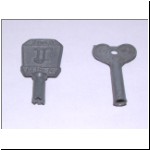 It was the discovery of a clockwork key that gave me
the first clue as
to the manufacturer of these intriguing models. The die-cast key
came with one of the clockwork trucks, and the words RIVER SERIES were
cast on each side, above and below the entwined letters J L. So I
started searching for possible die-cast toy manufacturers with these
initials, and identified Jordan & Lewden Ltd. as a likely candidate
(see Model Collector, May
1994, page 14). It was the discovery of a clockwork key that gave me
the first clue as
to the manufacturer of these intriguing models. The die-cast key
came with one of the clockwork trucks, and the words RIVER SERIES were
cast on each side, above and below the entwined letters J L. So I
started searching for possible die-cast toy manufacturers with these
initials, and identified Jordan & Lewden Ltd. as a likely candidate
(see Model Collector, May
1994, page 14).
This company was incorporated around 1950 and appeared in the London
street directories as 'toy manufacturers'. Their address was 52A
Brooksby's Walk, Homerton, London, E.9. In the trade magazine
Games & Toys there is a reference to them as manufacturers of
die-cast metal toys. Unfortunately, these references are all too
brief, and the firm seems to have made very little attempt to market
itself and its products to either the trade or to consumers.
However, more recently Andrew Ralston followed up the reference to
Jordan & Lewden Ltd. by contacting Lewden Metal Products Ltd., who
are still in existence in east London. This company confirmed
that Jordan & Lewden had indeed made the River Series toys.
It should also be mentioned that in the past, collectors often
attributed the River Series to DCMT (Die Casting Machine Tools Ltd.),
the makers of Lone Star toys, possibly because the DCMT factory in
Palmers Green, north London was known as 'River Works'.
Unfortunately this error has been perpetuated over the years in several
published books and articles, but is quite incorrect.
The Cars
There
were six cars in the range, all based on actual vehicles from 1953 or
1954. They were generally a little larger than contemporary Dinky
Toys, about 1:40 scale, and initially had friction drive motors.
The models were painted in a limited number of single tone colours -
only two or three colours can be found for most of them. Silver
trim was generally not applied, and models that have it may well have
been decorated by a previous owner rather than in the factory.
Several models have also been seen in a chrome plated finish.
The die-cast baseplates were unpainted, and wheels were unpainted metal
with large smooth black rubber tyres. Later models had treaded
solid rubber wheels which were of two types, either with fine treads
and symmetrical in cross-section, or with a projection on the inside to
attach to the axle and a domed appearance on the outside. The
rubber wheels were a bought-in component, and can also be found on
other toys which had no connection with the River Series.
 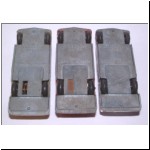 Non-motorised versions of the models were also made,
and these had a
tinplate pressing riveted to the inside of the base in place of the
motor to support the rear axle. The Buick, Vanguard Estate and Daimler Conquest
also exist with a casting modification to provide die-cast rear axle
supports and delete the tinplate component, thus removing the
possibility of a motor. It would be interesting to know if the
others were modified in this way. Non-motorised versions of the models were also made,
and these had a
tinplate pressing riveted to the inside of the base in place of the
motor to support the rear axle. The Buick, Vanguard Estate and Daimler Conquest
also exist with a casting modification to provide die-cast rear axle
supports and delete the tinplate component, thus removing the
possibility of a motor. It would be interesting to know if the
others were modified in this way.
 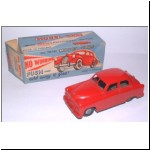 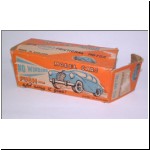 A standard type of box was used, printed in blue and
red or orange and blue,
with an
illustration of the Austin A40. The box made a great feature of
the 'no winding' friction motor. The end flaps showed the name of
the actual model contained within. A standard type of box was used, printed in blue and
red or orange and blue,
with an
illustration of the Austin A40. The box made a great feature of
the 'no winding' friction motor. The end flaps showed the name of
the actual model contained within.
 I also have a box for the 'Rally Car Series' in red and
yellow with
something like a Sunbeam-Talbot shown on the front and an Aston Martin
on the sides. Presumably this was a later box because there was
no mention of the friction motor. Again, the actual model name
was printed on the end flaps, in this case 'Standard Estate Wagon'. I also have a box for the 'Rally Car Series' in red and
yellow with
something like a Sunbeam-Talbot shown on the front and an Aston Martin
on the sides. Presumably this was a later box because there was
no mention of the friction motor. Again, the actual model name
was printed on the end flaps, in this case 'Standard Estate Wagon'.
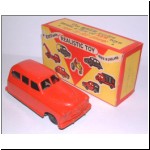 Later versions of the cars
came in the same red and yellow River Series box as used for the trucks. Later versions of the cars
came in the same red and yellow River Series box as used for the trucks.
The
individual models were as follows.
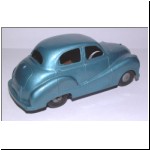 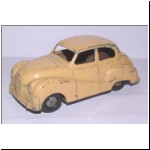 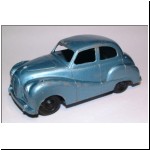 Austin A40 Somerset Austin A40 Somerset
Length 98mm. Larger than the Dinky Toy, this model was too wide
but its curves were quite evocative of the rounded lines of the real
car. Cast on the baseplate was AUSTIN A 40 MODEL and MADE IN
ENGLAND.
Colours: Metallic blue; non-metallic blue; red; beige.
  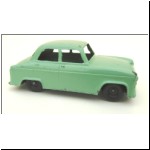 Ford Prefect 100E Ford Prefect 100E
Length 97mm. In my opinion this was the least attractive of the
cars. The bonnet was too long and the grille and headlights were
poorly modelled. FORD PREFECT and MADE IN ENGLAND were cast
underneath.
Colours: Orange; green; red;
pale green.
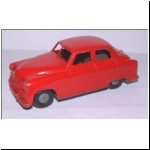 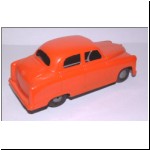 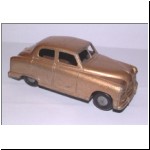 Standard Vanguard Phase II Saloon Standard Vanguard Phase II Saloon
Length 101mm. I believe this was the only contemporary model of
the Phase II Vanguard. Again it was rather let down by the poor
modelling of the front of the bonnet and the grille. STANDARD
VANGUARD and MADE IN ENGLAND were cast on the baseplate.
Colours: Red; orange; metallic
gold.
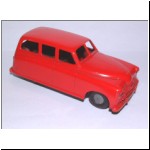  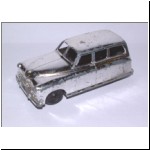 Standard Vanguard 2-door Estate
Car Standard Vanguard 2-door Estate
Car
Length 98mm. Similar comments apply as for the Vanguard
saloon. STANDARD ESTATE WAGON and MADE IN ENGLAND were cast
underneath.
Colours: Red; beige; chrome
plated.
  Daimler Conquest Daimler Conquest
Length 100mm. A reasonably good model, and much the best of the
series. DAIMLER CONQUEST and MADE IN ENGLAND cast underneath.
Colours: Mauve; green; chrome
plated. Also as an
army staff car in very dark glossy green.
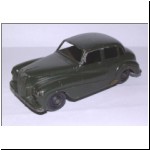 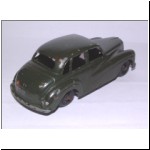
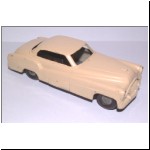  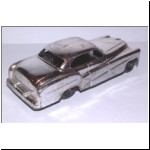 1953 Buick Coupe 1953 Buick Coupe
Length 108mm. The absence of silver trim on the River Series cars
is quite significant on this model, since heavy chrome was such an
important part of American car styling of the time. The orange
Buick in the illustration does look better than the cream model, even
if the silver trim is not original. On the baseplate was cast
AMERICAN BUICK and MODEL MADE IN ENGLAND.
Colours: Cream; orange; red; chrome
plated.
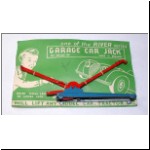 Garage Car Jack Garage Car Jack
Length of trolley
83mm This trolley jack was strung
onto a display card, which was the only means of identifying it as a
River Series model. CAR JACK was cast on the top of the base, and
MADE IN ENGLAND underneath. There was a spring wire underneath,
keeping the brake lever engaged with the ratchet wheel, so that the
jack stayed in the elevated position until the brake lever was
lifted. Painted red and blue.
The New Zealand
Issues
In the late 1950s, New Zealand tightened import
restrictions and exchange controls, and in fact from 1958 there was a
total prohibition on importing toys (according to David Daw in his book
Micro Models: A Collectors'
Guide). Lincoln Industries Ltd. was a New Zealand toy
importer and manufacturer (based in Auckland) and the import ban meant
that home production was essential. Lincoln produced the
Australian Micro Models range using dies hired in from Australia.
At least three of the cars from the River Series were also made by
Lincoln in New Zealand, and it seems very likely that a similar
arrangement operated, whereby Jordan & Lewden loaned the dies to
Lincoln. Alternatively, they may have supplied castings and other
components to Lincoln for assembly in New Zealand.
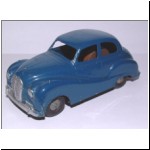 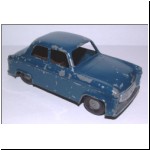 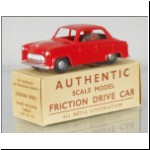 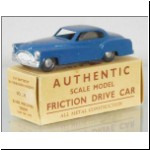 New
Zealand versions
are known of the Austin A40, Ford
Prefect and
Buick. They all had friction motors and die-cast wheels with
smooth black tyres, identical to the UK models. I have New
Zealand versions of the Austin A40 and Ford Prefect. Both are
painted dark blue, and differ from the UK
models in having spray painted silver trim front and rear, and black
painted baseplates.
New
Zealand versions
are known of the Austin A40, Ford
Prefect and
Buick. They all had friction motors and die-cast wheels with
smooth black tyres, identical to the UK models. I have New
Zealand versions of the Austin A40 and Ford Prefect. Both are
painted dark blue, and differ from the UK
models in having spray painted silver trim front and rear, and black
painted baseplates.
 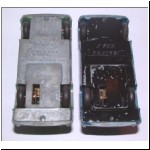  The sure way to tell
a New Zealand issue is
that MADE IN ENGLAND does not appear on the baseplate, and on my
examples
the offending lettering seems to have been machined off the base after
casting, rather than modify the die. The sure way to tell
a New Zealand issue is
that MADE IN ENGLAND does not appear on the baseplate, and on my
examples
the offending lettering seems to have been machined off the base after
casting, rather than modify the die.
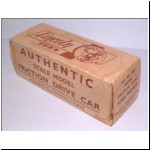 New Zealand models
had rather plain boxes with 'Lincoln Toys' on the
face, 'Authentic Scale Model Friction Drive Car All Metal Construction'
on the sides, and 'Model Friction Series
Lincoln Industries Ltd. Auckland N.Z.' on the end flaps, together with
the model name and catalogue number. Thanks to Ron Ford who found this
example for me. New Zealand models
had rather plain boxes with 'Lincoln Toys' on the
face, 'Authentic Scale Model Friction Drive Car All Metal Construction'
on the sides, and 'Model Friction Series
Lincoln Industries Ltd. Auckland N.Z.' on the end flaps, together with
the model name and catalogue number. Thanks to Ron Ford who found this
example for me.
If the dies went to New Zealand, they must have returned to the UK,
because we know that certainly the Buick and Ford Prefect were
subsequently produced in Israel - of which more later.
River Series
Trucks
The
River Series of trucks was based around two models: a forward control
lorry, to which various different truck bodies were attached, and a
normal control articulated cab with various
trailers.
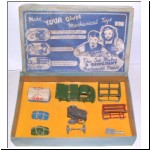 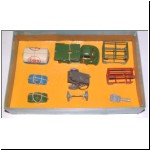  The forward control
model had a very deep chassis
section to
incorporate a clockwork motor driving the rear axle. The motor
was attached by tabs through the rear flat part of the chassis,
partly covered by a tray-like flat bed riveted on top. Different
bodies were slotted in to this flat bed and were mostly removable, so
that incomplete models are quite often found. There was also a Gift Set
containing
one truck with three interchangeable bodies. The forward control
model had a very deep chassis
section to
incorporate a clockwork motor driving the rear axle. The motor
was attached by tabs through the rear flat part of the chassis,
partly covered by a tray-like flat bed riveted on top. Different
bodies were slotted in to this flat bed and were mostly removable, so
that incomplete models are quite often found. There was also a Gift Set
containing
one truck with three interchangeable bodies.
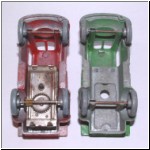 Non-motorised models were also made, with cast metal
supports for the
rear axle. There are some detail differences which make me think
that there were actually two dies to make the mechanical or
non-mechanical versions. In addition, a completely new die was
later made for many of the military models, and will be described in
that section. Non-motorised models were also made, with cast metal
supports for the
rear axle. There are some detail differences which make me think
that there were actually two dies to make the mechanical or
non-mechanical versions. In addition, a completely new die was
later made for many of the military models, and will be described in
that section.
The
civilian forward control trucks had metal wheels, usually
unpainted, but some have
black painted wheels with red
hubs. Most models had MADE IN ENGLAND cast under the cab roof,
but this was absent on some early versions.
The truck was obviously not based on any real vehicle, and the design
probably owes more to the need to use a simple three-piece die, without
the expense of a slide to make any more authentic grille detail.
The articulated cab was cast from an even simpler two-piece die.
The articulated models probably came later than the forward control
trucks, because they always had rubber wheels and no attempt was made
to include a motor. MADE IN ENGLAND was absent at first, and
later cast underneath the cab.
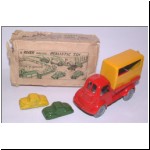 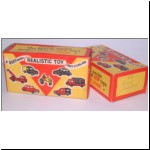 Three types of boxes were used for the civilian
trucks. Firstly
there was an off-white box printed in black and green with a crude
roadway scene on the face. Above the illustration were the words
'A River Series Realistic Toy' which seems something of a joke given
the crudity of the models! This box was superseded by a red and
yellow version with approximate illustrations of some items in the
series and others which bear no relation to the models produced. Three types of boxes were used for the civilian
trucks. Firstly
there was an off-white box printed in black and green with a crude
roadway scene on the face. Above the illustration were the words
'A River Series Realistic Toy' which seems something of a joke given
the crudity of the models! This box was superseded by a red and
yellow version with approximate illustrations of some items in the
series and others which bear no relation to the models produced.
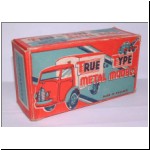 There was also a red and blue box proclaiming 'True to
Type Metal
Models' - another somewhat misleading slogan. The 'True to Type' boxes
had the model name printed on the end flaps, whereas on the others the
name was rubber stamped or hand written. There was also a red and blue box proclaiming 'True to
Type Metal
Models' - another somewhat misleading slogan. The 'True to Type' boxes
had the model name printed on the end flaps, whereas on the others the
name was rubber stamped or hand written.
The
following versions of the civilian trucks have been noted.
 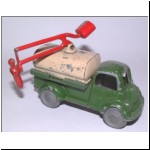 Gully Emptier Gully Emptier
A tanker body was fitted and the model had a movable boom extending
over the cab with a hose attached. The bottom of the hose was
secured through a hole in the front bumper. This hole can be seen
on all the forward control trucks by looking at the model from
underneath.
Colours: Dark green or
light blue cab/chassis,
cream tank, red boom.
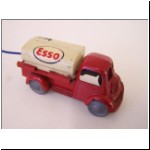  Tanker Tanker
Similar to the
Gully Emptier, but without the boom and with a plastic filler hose.
Colours: Red or dark green
cab/chassis,
cream tank, one or two "Esso" transfers.
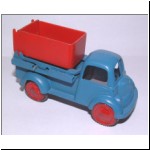 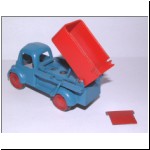 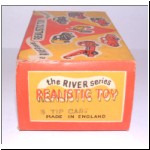  Tipper Lorry
Tipper Lorry
Length 94mm. A die-cast frame was fitted to the flat bed to
retain a bent wire tipping lever. The tipping body was hinged on
the frame and had a separate removable tailboard (later a hinged tailboard, not
removable).
Colours: Blue cab/chassis, frame and lever, red tipper; or red cab/chassis and tipper,
unpainted frame and lever.
 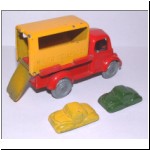 River Transport Lorry River Transport Lorry
Length 101mm. This had a box van body but with long open windows
either side. RIVER TRANSPORT was cast below the windows and there
was a let-down tailboard. Two miniature cars were supplied with this
model, presumably intended to be carried inside! These were
one-piece castings with MADE IN ENGLAND underneath (length 33mm).
Colours: Green cab/chassis with
red body, or red cab/chassis with yellow body. Miniature
cars yellow,
dark
green, red or blue.
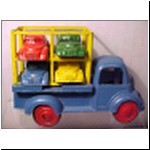 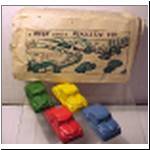  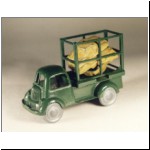
Car Carrier
Length 94mm. This had a simple frame-like body with no fewer than
four of the miniature cars. When piled up inside, they look as if
they are on their way to the scrap yard.
Colours: Dark green, red or
blue cab/chassis, dark green,
red or yellow body. Miniature cars yellow, dark green, red or blue.
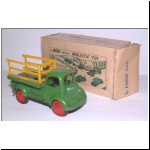 Farm
Lorry Farm
Lorry
An open stake truck
type of body with a hinged tailgate (missing on the example
shown). On the box end flap is rubber stamped "1. FARM CAR".
Colours: Dark green or green cab/chassis, red or yellow body.
Horse Transporter
I think this was the same model as the farm lorry, with two horses
inside (not illustrated).
Colours: Dark green, brown horses.
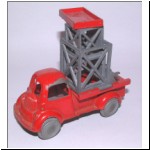 Tower Wagon Tower Wagon
Length 94mm. The tower was slotted in to the flat bed as usual,
and consisted of a two-piece tower structure with a separate platform
at the top which could be rotated. The top section of the tower
was raised by a crude arrangement of a wire handle and string.
Colours: Red cab/chassis, unpainted tower and red platform.
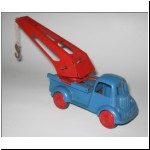 Crane Crane
Length 94mm. The crane consisted
of a tinplate pressing riveted
to a die-cast base which slotted in to the flat bed on the truck. This
allowed the crane to rotate. The hook and winding handle were
crudely made of bent wire. Colours: Blue cab/chassis, red
crane and base.
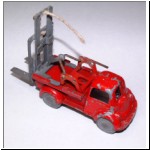 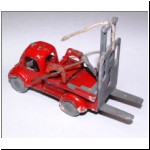 Fork-Lift
Truck Fork-Lift
Truck
Length 122mm
(max). The fork-lift mechanism could slide along the bed of the
truck by operating the rearmost wire lever (of two) that passed through
a cradle at the front of the bed. In the model pictured, the
front wire lever is missing, but it would have served as a winder for
the string to raise and lower the forks. When the mechanism was
slid to the rearmost position on the bed, the forks could be lowered to
the ground. Colours: Green cab/chassis with red cradle and fork-lift
mechanism; or red cab/chassis with red cradle and unpainted
fork-lift mechanism.
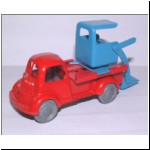  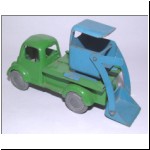 Excavator Excavator
Length 114mm. The excavator had a cab which slotted in to the
flat bed, and attached to it a movable arm with lever and a movable
bucket on the end.
Colours: Green or red
cab/chassis, blue excavator.
 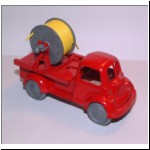 Cable Layer Cable Layer
Length 94mm. This model had a cable drum (wound
with plastic cable) mounted vertically in a frame attached to
the usual forward control cab/chassis.
Colours: Green
cab/chassis, unpainted cable drum and support; or red cab/chassis and drum support,
unpainted cable drum.
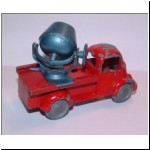 Cement
Mixer Cement
Mixer
Length 94mm. The cement mixer
consisted of no fewer than six separate die-castings, and maybe the
complexity of the assembly accounts for its rarity. The base
(which slotted into the flat bed on the truck) was the same component
as used on the crane and excavator.
Colours: Red cab/chassis, metallic blue cement mixer.
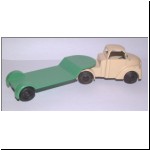 Articulated Low Loader Articulated Low Loader
Length 163mm. The simple low loader trailer had no identification
cast on it. On one of the box end flaps, this model has '22 Low
Loader' hand written in pencil.
Colours: Cream or red cab; green trailer. See also the military
version.
 Articulated Flat Lorry Articulated Flat Lorry
Length 145mm. With or without MADE IN ENGLAND cast underneath the
trailer. '36 Artic Truck' was hand written on the box flap of the
example shown.
Colours: Dark green or cream cab, red trailer.
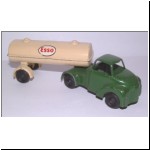 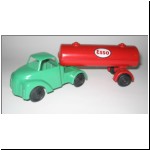 Articulated Tanker Articulated Tanker
Length 151mm. The tank was a two-piece casting, plus a separate
piece for the rear mudguards and axle supports. This was in fact the
same component as used on the flat lorry.
Colours: Dark green or green
cab, cream or red trailer
with 'Esso' transfer on each
side.
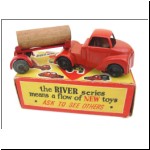 Articulated
Timber Transporter Articulated
Timber Transporter
This had a piece of dowel
as a "log" load.
Colours: Red cab and
trailer.
Here Comes The
Army
Both
the forward control truck and the articulated truck were used as the
basis for various military models, and there were also specific army
items in the form of a jeep,
armoured car, field gun and gun limber. There was also a Daimler Conquest
staff car, mentioned above.
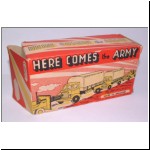  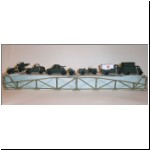 Most of these items
came in a red and yellow box with
'Here Comes the
Army' shown on all four sides. The front face showed a military
convoy with two wagons, a jeep and a field gun. There
was also
a 'Here Comes the Army' Gift Set containing seven items, with a
box which could be made into a Bailey bridge. The models were
attached by string to a separate card base, and No.67 was printed on
the end flaps. Most of these items
came in a red and yellow box with
'Here Comes the
Army' shown on all four sides. The front face showed a military
convoy with two wagons, a jeep and a field gun. There
was also
a 'Here Comes the Army' Gift Set containing seven items, with a
box which could be made into a Bailey bridge. The models were
attached by string to a separate card base, and No.67 was printed on
the end flaps.
Earlier military models were painted a very dark glossy green, later
changed
to a matt finish. The individual models were as follows.
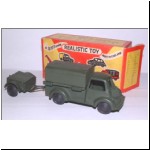 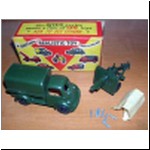 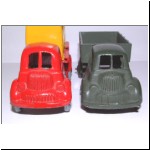 Army Covered Wagon Army Covered Wagon
This was the forward control truck with a tin tilt slotted directly on
to the flat bed. At some point
in the model's life, the truck casting was replaced by a completely new
die. There were many differences, particularly in the grille
where the new casting had fewer and more widely spaced bars (see
photo). Also, MADE IN ENGLAND was cast lengthwise under the rear
body rather than under the cab roof, and there was no longer any
provision to fit a clockwork motor. The flat bed body was deleted in
favour of two separate cross members, one of which was riveted at
the rear of the chassis and the other behind the cab. The new
casting had a towing hook at the rear for the limber and gun. The
first casting usually had unpainted metal wheels, and the later type
had rubber wheels.
Colours: Very dark green, gloss or matt.
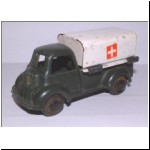 Army
Ambulance Army
Ambulance
Same as the covered wagon
but with a white painted tilt and red cross transfers on each
side. Second casting, rubber wheels.
Colours: Very dark green
(gloss or matt),
white tilt.
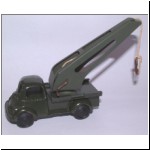 Army Crane Army Crane
Length 94mm. Similar to
the civilian version but without the clockwork motor. The
truck was the first casting, but
in this case had rubber wheels.
Colours: Very dark gloss green truck, very dark matt green crane.
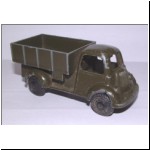 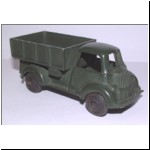 Army Open Wagon Army Open Wagon
Length 101mm. This model was produced on both the first and second
truck
casting. The open wagon body was riveted directly to the
chassis. Rubber wheels were fitted. An example with a tinplate tilt is
shown in the Bailey Bridge set above.
Colour: Dark brownish green
(first casting); very dark matt green (second casting).
 Army Tanker Army Tanker
Length 101mm. This used the second type casting. A
tanker body was slotted in to the cross members and trapped a plastic
hose in position. At the free end of the hose a
die-cast filler nozzle was fitted. Rubber wheels.
Colour: Very dark matt green.
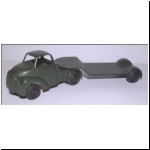 Army Articulated Low Loader Army Articulated Low Loader
Length 163mm. This was identical to the civilian model.
MADE IN ENGLAND was cast under the cab, and rubber wheels were fitted.
Colour: Very dark matt green.
  Jeep Jeep
Length 91mm. This
had
a separate baseplate on which was cast "HERE COMES THE ARMY" SERIES
JEEP MADE IN ENGLAND. There was a towing hook at the rear, a
separate steering wheel, and a plastic
windscreen. Solid rubber wheels.
Colour: Very dark matt green, or matt grey-brown (a sandy colour).
 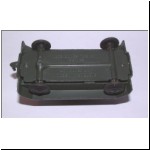 Armoured Car Armoured Car
Length 97mm. This consisted of a body with towing hook, a
separate rotating turret including a gun and a separate baseplate on
which was cast ''HERE COMES THE ARMY'' SERIES ARMOURED CAR MADE IN
ENGLAND. Solid rubber wheels.
Colour: Very dark matt green.
 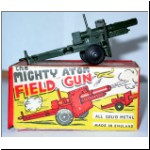 Field Gun Field Gun
Length 101mm. Similar guns, designed to fire matchsticks etc.,
were made by many manufacturers including Lone Star, Benbros and
Kemlows as well as Jordan & Lewden. The Lone Star and
Benbros versions carried the maker's name, while the Kemlows version
had no lettering cast on it but had the distinctive Kemlows die-cast
wheels with rubber tyres. The Jordan & Lewden model
came with or without MADE
IN ENGLAND cast and was available in an individual
box. Wheels were unpainted metal or solid rubber.
Colours: Red; matt brownish green; very dark matt green.
The red painted version is rather unlikely for a field gun!
Limber
Length 63mm. Again Kemlows made a very similar model. The
Kemlows model had a separately cast towing hook and MADE IN ENGLAND in
a circle underneath, whereas on the Jordan & Lewden
model the hook was cast with the body and there was no cast
lettering. Solid rubber wheels were fitted.
Colour: Very dark matt green.
Railway
Locomotives
There
were four or possibly five railway locomotives in the River
Series. These models were cast in two halves with a join down the
centre line which allowed a lot of detail to be included while still
using relatively simple dies. Two types of box have been seen,
the first having 'Engines Through the Ages' on the face together with
crude illustrations of four models, recognisable as Stephenson's
Rocket, Old Copperknob, the Stirling single and a 4-6-0 streamlined
loco that has yet to turn up. This box was in fact created by
applying a printed label over one face and two end flaps of the
standard early box for the River Series trucks. The end flap declared
'Full Descriptive Leaflet with each Engine Sold'.
The later box type was individually printed for each model in dark
blue, with the series now called 'Engines of History'. The
model's scale was quoted and technical data was listed on the rear of
the box rather than in a separate leaflet.
The four models confirmed to exist are as follows.
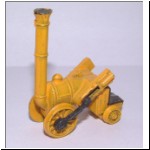 Stephenson's Rocket Stephenson's Rocket
Length 48mm. ROCKET cast on each side, MADE IN ENGLAND cast on
the left side.
Colours: Yellow with black connecting rods and black trim.
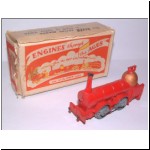  Furness Railway 'Old Copperknob' Furness Railway 'Old Copperknob'
Length 90mm. An 0-4-0 open locomotive, designated No.2 in the
series on the box. With or without MADE IN ENGLAND cast.
Colours: Red or dark green;
gold boiler, black trim, unpainted wheels and
connecting rods.
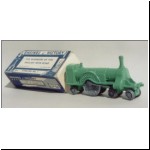 GNR Stirling No.1 GNR Stirling No.1
Length 110mm. A 4-2-2 locomotive with a single pair of driving
wheels.
Colours: Green, unpainted wheels and connecting rods.
 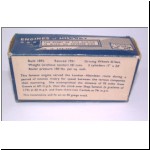 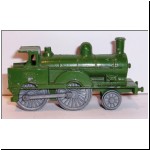 LNWR 2-4-0 Locomotive 'The Hardwicke' LNWR 2-4-0 Locomotive 'The Hardwicke'
Length 105mm. This model was not shown on the 'Engines Through
the Ages' box, but is clearly part of the same series and was certainly issued
in an 'Engines of History' box. The number 790 was cast on
the cab sides. With or
without MADE IN ENGLAND cast on the right side above the number.
Colours: Red or green, unpainted wheels and connecting rods.
Made in Israel
In
the early 1960s, many of the River Series dies were sold to Israel
where they were produced under the Gamda name. An article on
Gamda by Andrew Ralston appeared in Model
Collector in March 1994, and
more recently he has published a small booklet on the subject.*
The cars lost their friction motors but gained plastic windows.
The Daimler and Buick were given two-tone colour schemes and the
Vanguard Estate was issued as an ambulance. The Ford Prefect was
also reissued, but the Austin A40 and Vanguard Saloon were not.
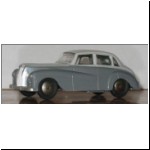 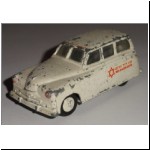  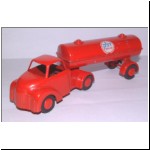 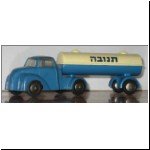 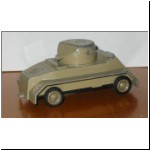
The forward control truck (second casting) was issued
with a tin tilt
or with the open wagon body, both models in military or civilian
versions. The articulated tanker appeared in several different
liveries, and the articulated flat truck, articulated timber transporter, jeep,
armoured car and field gun
were also
made. Gamda also acquired dies from Kemlows and Charbens at the
same time, so that a large proportion of the initial Gamda range
originated in north London!
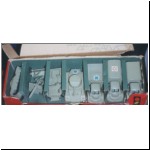 
Confusingly, Gamda made a limber and
field gun from the former Kemlows dies as well as the Jordan &
Lewden field gun. In the
photos above, the field gun on the right is from the Jordan &
Lewden dies, with MADE IN ISRAEL on the back of the shield in place of
the original MADE IN ENGLAND lettering. The Gamda Army Set on the
left contains a field gun and limber from the Kemlows dies.
The River Series therefore came to an end, but not before setting in
train a course of confusion and questions for collectors for the next
40 years. Hopefully some of these have now been answered.
Acknowledgements
Thanks to Vic Davey, Ron Ford,
John Garside, Brian & Hilary Gatward, Hadi Orr,
Colin
Penn, Andrew Ralston,
Brian Salter and Patrick Trench
who provided photos or
loaned
models
for photographing, and also to Peter Corley and Nigel Robertshaw for
additional
information.
*Reference
Model
Cars from Israel by
Andrew Ralston, published by the author, 2002.
|









































































































